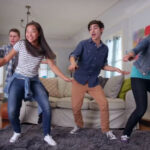The other day, while sorting through some mundane tasks at home, I stumbled upon a SiriusXM station called “80s Chillpill.” The name itself evoked a certain feeling, and as the music began to play, I was instantly transported. It wasn’t the kind of music that topped my personal favorites list from the decade, but it was deeply evocative of the 1980s era – a time when slow dances at school events were a defining social ritual. This experience sparked a reflection on the powerful nostalgia associated with 1980s Dance music and the broader cultural landscape it represents.
The station’s playlist was a roll call of quintessential 80s ballads: REO Speedwagon’s “Can’t Fight This Feeling,” Wham!’s “Careless Whisper,” Simply Red’s “Holding Back the Years,” and Air Supply’s “Lost in Love.” These weren’t necessarily the high-energy tracks that filled dance floors at clubs, but they were the soundtrack to countless school dances, proms, and quiet moments of teenage introspection. They represent a softer side of the 80s music scene, one that was just as formative for many. There were also tracks like Kenny G’s “Songbird,” Peter Cetera’s “Glory of Love” from The Karate Kid Part II, and UB40’s reggae-infused cover of “Red Red Wine.” These songs, while diverse in style, collectively paint a picture of the sonic backdrop of the decade. Even duets like “Islands in the Stream” by Kenny Rogers and Dolly Parton, and “We’ve Got Tonight” by Kenny Rogers and Sheena Easton, contributed to this mellow, romantic vibe that was prominent in 1980s popular music.
Growing up in the 1980s meant experiencing music in a fundamentally different way than we do today. Personal music libraries were limited, primarily consisting of records and cassettes. Radio, therefore, played a crucial role in shaping musical tastes and exposing listeners to a wide range of songs. Top 40 radio was a constant presence, broadcasting a curated selection of hits that permeated the cultural consciousness. You heard what was played, whether you actively chose it or not, and this shared listening experience created a collective musical memory for a generation. MTV, emerging in the early 80s, also began to influence music consumption, but radio remained a dominant force, especially in local communities. This pre-internet, pre-personalized playlist era meant that songs, even those not individually chosen or particularly favored, became deeply intertwined with personal memories and experiences simply through repeated exposure.
This brings us to the heart of 1980s dance nostalgia. It’s not just about the specific songs themselves, but what they represent. These “slow songs for an eighth-grade dance” evoke a specific period of life – adolescence, teenage years, the formative experiences of growing up. They are sonic timestamps that transport us back to school dances, awkward slow dances, and the emotional landscape of youth. The appeal lies in the connection to a time of self-discovery, social development, and perhaps a simpler world, despite its own complexities.
Consider the cultural impact of 1980s dance beyond just the music. The decade was a melting pot of dance styles. From the energetic breakdancing that emerged from hip-hop culture to the flamboyant moves of disco’s evolution and the burgeoning influence of pop and rock on dance floors, the 80s were visually and rhythmically dynamic. Movies like Footloose and Dirty Dancing further cemented the importance of dance in 80s culture, showcasing both choreographed routines and the raw expression of movement. Fashion played a significant role, with vibrant colors, leg warmers, and iconic hairstyles all contributing to the visual identity of 1980s dance culture.
The nostalgia for 1980s dance, therefore, is multifaceted. It’s a longing for the music, yes, but it’s also a yearning for the feelings, experiences, and cultural context associated with that era. It’s about remembering Friday night dances, the excitement (or dread) of being asked to slow dance, the fashion, the movies, and the overall vibe of a decade that shaped a generation. It’s less about a painful longing for specific songs, and more about a poignant connection to a past self and the collective memories of a time when 1980s dance music provided the soundtrack to growing up.
Perhaps the enduring appeal of revisiting 1980s “chill” playlists, or any 80s dance music for that matter, lies in their very ubiquity during that time. Because these songs were often heard passively, on the radio, at events, or in the background of daily life, they became intertwined with a vast and varied tapestry of memories. Happy, sad, exciting, mundane – these songs were the backdrop to it all. They are musical keys that unlock not just memories of specific events, but the broader atmosphere and feeling of a formative period in our lives. And that, perhaps, is the true power of 1980s dance nostalgia.

